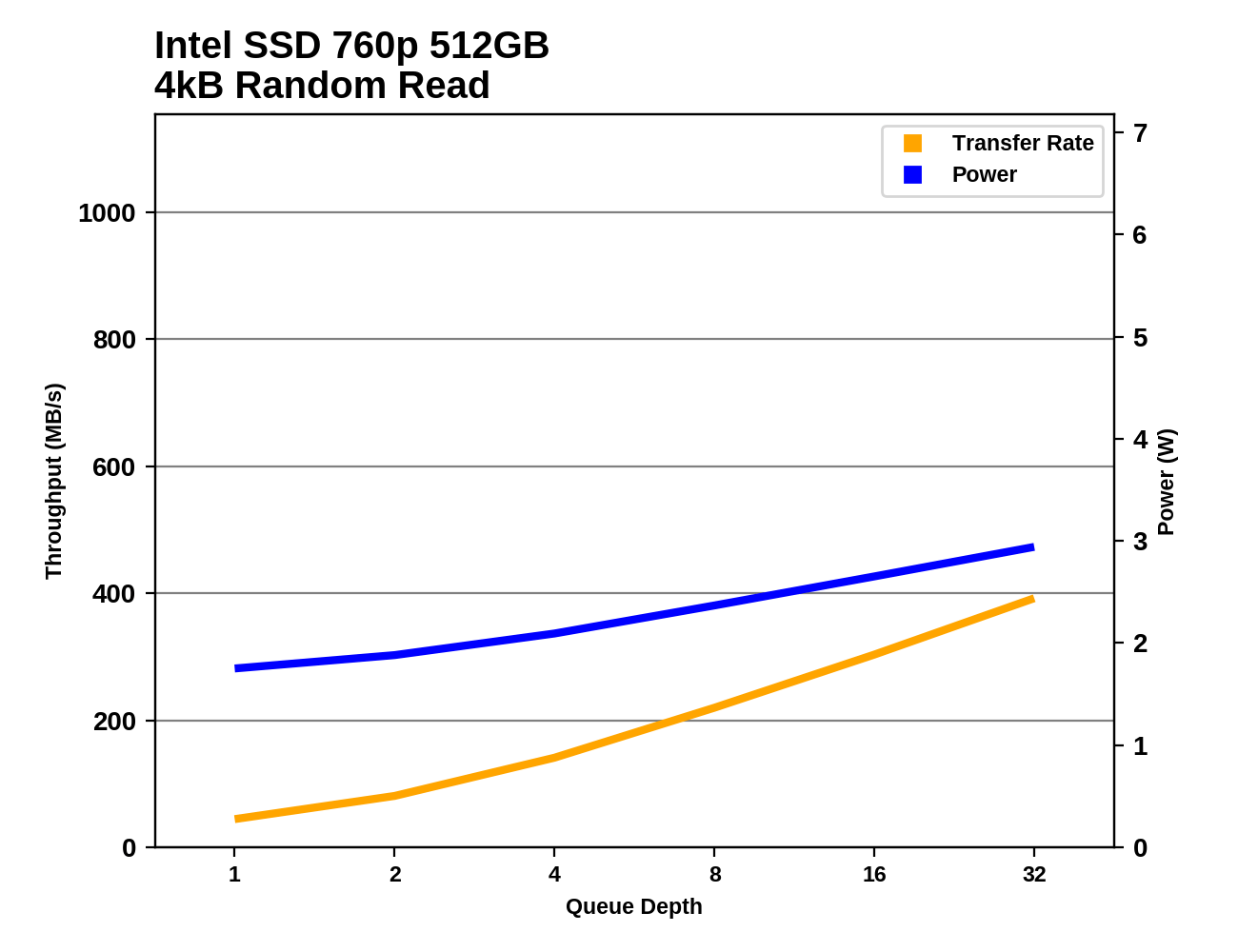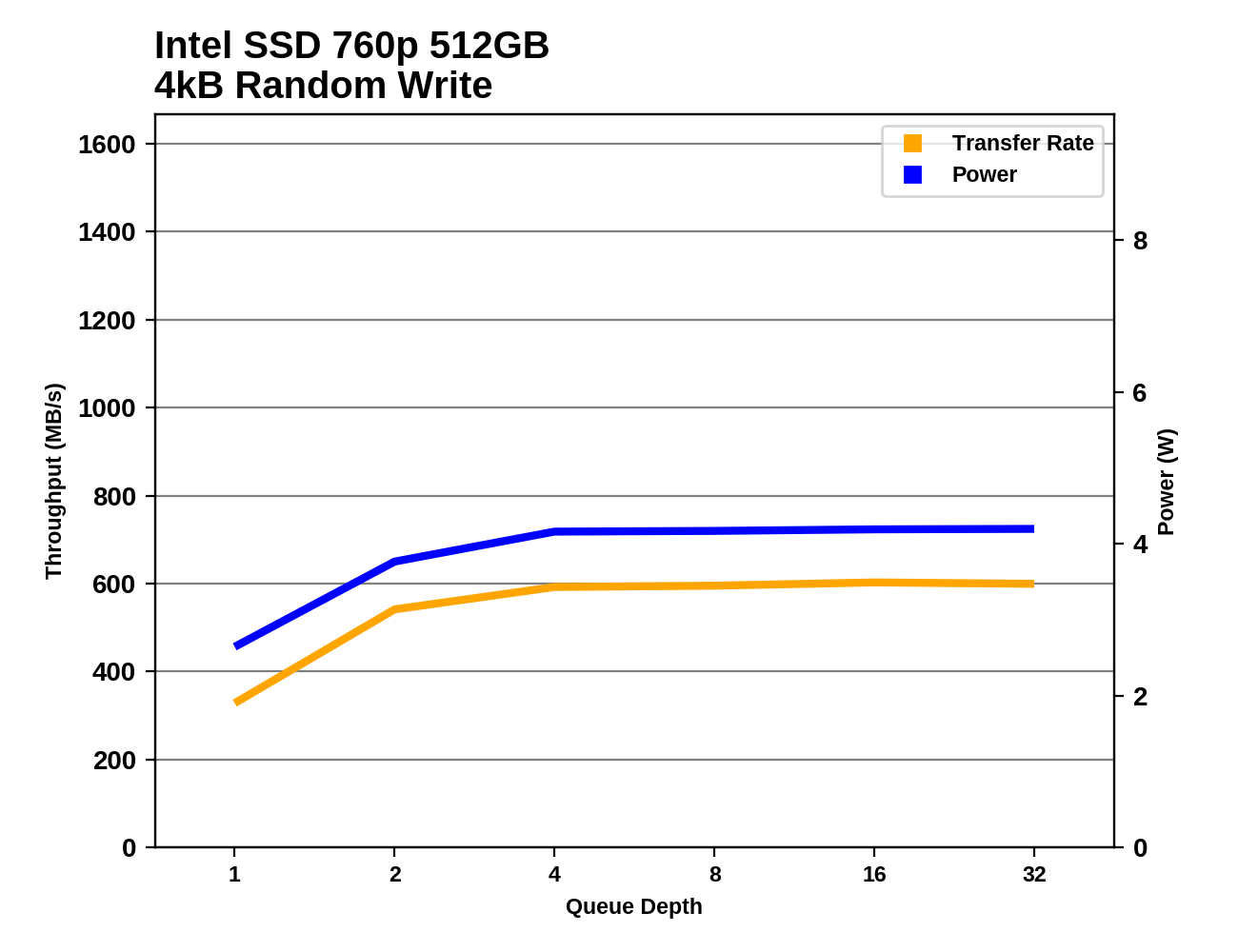The Intel SSD 760p 512GB Review: Mainstream NVMe Done Right
by Billy Tallis on January 23, 2018 11:30 AM ESTRandom Read Performance
Our first test of random read performance uses very short bursts of operations issued one at a time with no queuing. The drives are given enough idle time between bursts to yield an overall duty cycle of 20%, so thermal throttling is impossible. Each burst consists of a total of 32MB of 4kB random reads, from a 16GB span of the disk. The total data read is 1GB.

The burst random read performance of the Intel SSD 760p is great, even when compared against MLC-based NVMe SSDs. Samsung's 960 PRO is the only flash-based consumer SSD that currently beats the read latency of the 760p. The 760p has more than doubled the QD1 random read performance of the Intel SSD 600p, and is 17% faster than the Intel SSD 750.
Our sustained random read performance is similar to the random read test from our 2015 test suite: queue depths from 1 to 32 are tested, and the average performance and power efficiency across QD1, QD2 and QD4 are reported as the primary scores. Each queue depth is tested for one minute or 32GB of data transferred, whichever is shorter. After each queue depth is tested, the drive is given up to one minute to cool off so that the higher queue depths are unlikely to be affected by accumulated heat build-up. The individual read operations are again 4kB, and cover a 64GB span of the drive.

With a longer test runtime and some higher queue depths involved, the Intel SSD 760p no longer stands out from the crowd. Its sustained random read performance is reasonable given its pricing and the current field of competitors, but in a few months time it may be looking rather sluggish. The 760p is about 5% slower than the Intel SSD 750, but on the other hand it is 54% faster than the 600p.

The power efficiency of the Intel SSD 760p during random reads is about average. Samsung's SSDs dominate the top half of the chart, and the two SATA SSDs hold the top two spots, showing that the performance of NVMe SSDs still doesn't offset their increased power consumption. Intel's previous consumer NVMe SSDs are tied for last place in power efficiency: the 750 is reasonably fast but power hungry, while the 600p has more modest power requirements but is quite slow.
 |
|||||||||
The Intel SSD 760p has decent random read performance at low queue depths, but it doesn't scale well at all with higher queue depths. By QD4, Samsung's drives have started pulling away, and at QD8 and higher most drives are faster than the 760p. Even Samsung's SATA SSDs have a clear lead over the 760p before they hit the wall of SATA performance limits. At QD32, most other NVMe drives are much faster than the 760p, and the high-end drives are all at least twice as fast.
The power consumption of the Intel SSD 760p during the sustained random read test is lower than any NVMe SSD we've tested so far except the Toshiba XG5.
Random Write Performance
Our test of random write burst performance is structured similarly to the random read burst test, but each burst is only 4MB and the total test length is 128MB. The 4kB random write operations are distributed over a 16GB span of the drive, and the operations are issued one at a time with no queuing.

The burst random write performance of the Intel SSD 760p is second only to the Intel SSD 750. Since the 750 is based on an enterprise SSD platform with MLC NAND, this regression isn't at all surprising. That the 760p manages to beat the Samsung 960 PRO is quite an accomplishment. The 760p is also 73% faster than the Intel 600p on this test.
As with the sustained random read test, our sustained 4kB random write test runs for up to one minute or 32GB per queue depth, covering a 64GB span of the drive and giving the drive up to 1 minute of idle time between queue depths to allow for write caches to be flushed and for the drive to cool down.

On the sustained random write test that involves some higher queue depths, the performance of the Intel SSD 760p is good but not outstanding. Several of Samsung's drives and the Intel SSD 750 are faster. However, the 760p is on par with some of the slower MLC-based competitors and is almost twice as fast as the Intel SSD 600p.

The power efficiency of the Intel SSD 760p during random writes is a bit above average, and is substantially better than any previous Intel consumer SSD. The Toshiba XG5 and most of Samsung's recent drives are far more efficient.
 |
|||||||||
The random write performance of the Intel SSD 760p saturates around QD4 at 600 MB/s. Most high-end NVMe drives continue showing improvement up to QD8, and the Samsung 960 PRO and EVO both top out with over twice the throughput of the Intel SSD 760p. The 760p is delivering twice the performance of the Intel SSD 600p with the same power consumption, but that's one of the few comparisons where the 760p is the clear winner.










51 Comments
View All Comments
Makaveli - Tuesday, January 23, 2018 - link
Its not on the charts because this is a review of budget drives.There would be no point to adding it to this review its in a different performance segment.
emvonline - Tuesday, January 23, 2018 - link
and you cant put it in a notebookiwod - Wednesday, January 24, 2018 - link
I think we have come a long since the first SSD review on Anandtech. And we still have yet to determined the one benchmarks that is representative of real world usage.With these sort of SSD performance I wondered if we are still bottlenecked by IO at all.
The Intel 512GB is now under $200 for MSRP, I bet street price will be even lower, and $100 cheaper then Samsung. While the 128GB and 256GB is much closer, mainly because the cost of controller is fixed, contributing to the bottom line pricing.
Which is why I am sadden, and a little angry, how Apple in 2018, being one of the largest NAND buyer and has an economy of scale, their own SSD Controller, is STILL shipping a HDD on iMac.
xchaotic - Wednesday, January 24, 2018 - link
So why would I want this over the slightly faster and cheaper 960 EVO? (espeically at 256GB it's faster)solar75 - Tuesday, January 30, 2018 - link
Dear BILLY, could you please test several NVME drives in several laptop models to see which ones provide the best speed? I think this will be a very popular review.Shirley Dulcey - Friday, August 31, 2018 - link
Half a year later we can see where the pricing has gone, and it's in a pleasant downward direction.I recently bought a 256GB 760p for a lower-end build (Ryzen 5 2400G, also a bargain at $110) and it's performing very well in that application. It was $60 that day ($65 right now), making it the least expensive option at that capacity other than the store brand drive. The 512GB is $125, but in that capacity class the Crucial MX500 is even more aggressively priced at $100. All in all a great time to be buying an SSD and CPU, but still a lousy one for RAM.
andras1 - Friday, February 8, 2019 - link
So is the 500 GB Intel 760p better in every single aspect (including latency, power, and small random writes/reads) than the 500 GB SATA Samsung 860 EVO?andras1 - Saturday, February 9, 2019 - link
How about full throttle maximum write/read speed power consumption?In which applications is 60ms wake up latency typically a problem? What does this translate to for the average user? Using Visual Studio for programming? Gaming? Internet? Video watching? Handling files?
FastCarsLike - Friday, May 24, 2019 - link
I don't get it, how is it still "TBD", this has been out for almost a year now.ktan112 - Tuesday, July 23, 2019 - link
Is my Intel 760p dying, I'm getting less than half the performance of your results from testing:https://www.userbenchmark.com/UserRun/18676663#DRI...